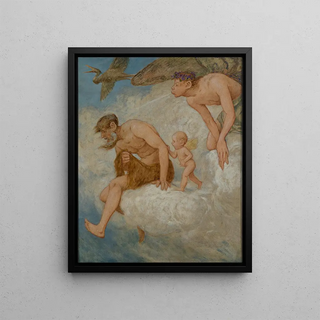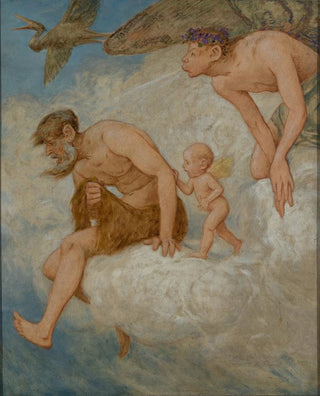Art print | Marche les dieux du vent - Hans Thoma


View from behind

Frame (optional)
In the vibrant universe of art, certain works stand out for their ability to evoke deep emotions and reflections on the human condition. "Walk the gods of the wind - Hans Thoma" is one of those creations that captivate the mind and soul. This piece, imbued with mystery and poetry, transports us to a world where nature and the divine meet, where elements blend harmoniously to give life to a scene of rare intensity. Through this art print, the viewer is invited to explore themes of spirituality, movement, and the beauty of landscapes, while immersing themselves in the unique atmosphere emanating from every detail.
Style and uniqueness of the work
Hans Thoma's style is a subtle blend of realism and idealism, characterized by meticulous attention to detail and a palette of vibrant colors. "Walk the gods of the wind" perfectly illustrates this duality. The human figures, though stylized, seem alive, almost in motion, as if they are dancing with the wind. The backgrounds, often adorned with majestic landscapes, add an extra dimension to the piece, creating an almost mythological atmosphere. Thoma manages to capture the very essence of nature, making it both tangible and spiritual. The play of light and shadow in this work is so delicate that it creates a sense of depth, allowing the viewer to dive into a universe where reality and fantasy coexist.
The artist and his influence
Hans Thoma, a German painter of the 19th century, is often regarded as one of the most influential representatives of the Romantic movement. His ability to fuse folkloric elements with mythological themes profoundly influenced his contemporaries and subsequent generations. Thoma was able to capture the collective imagination of his time by incorporating cultural and historical references into his works. His unique approach not only enriched the German artistic landscape but also paved the way for a deeper exploration of the relationship between man and nature. Through "Walk the gods of the wind," he succeeds in echoing the spiritual concerns of his

Matte finish

View from behind

Frame (optional)
In the vibrant universe of art, certain works stand out for their ability to evoke deep emotions and reflections on the human condition. "Walk the gods of the wind - Hans Thoma" is one of those creations that captivate the mind and soul. This piece, imbued with mystery and poetry, transports us to a world where nature and the divine meet, where elements blend harmoniously to give life to a scene of rare intensity. Through this art print, the viewer is invited to explore themes of spirituality, movement, and the beauty of landscapes, while immersing themselves in the unique atmosphere emanating from every detail.
Style and uniqueness of the work
Hans Thoma's style is a subtle blend of realism and idealism, characterized by meticulous attention to detail and a palette of vibrant colors. "Walk the gods of the wind" perfectly illustrates this duality. The human figures, though stylized, seem alive, almost in motion, as if they are dancing with the wind. The backgrounds, often adorned with majestic landscapes, add an extra dimension to the piece, creating an almost mythological atmosphere. Thoma manages to capture the very essence of nature, making it both tangible and spiritual. The play of light and shadow in this work is so delicate that it creates a sense of depth, allowing the viewer to dive into a universe where reality and fantasy coexist.
The artist and his influence
Hans Thoma, a German painter of the 19th century, is often regarded as one of the most influential representatives of the Romantic movement. His ability to fuse folkloric elements with mythological themes profoundly influenced his contemporaries and subsequent generations. Thoma was able to capture the collective imagination of his time by incorporating cultural and historical references into his works. His unique approach not only enriched the German artistic landscape but also paved the way for a deeper exploration of the relationship between man and nature. Through "Walk the gods of the wind," he succeeds in echoing the spiritual concerns of his






